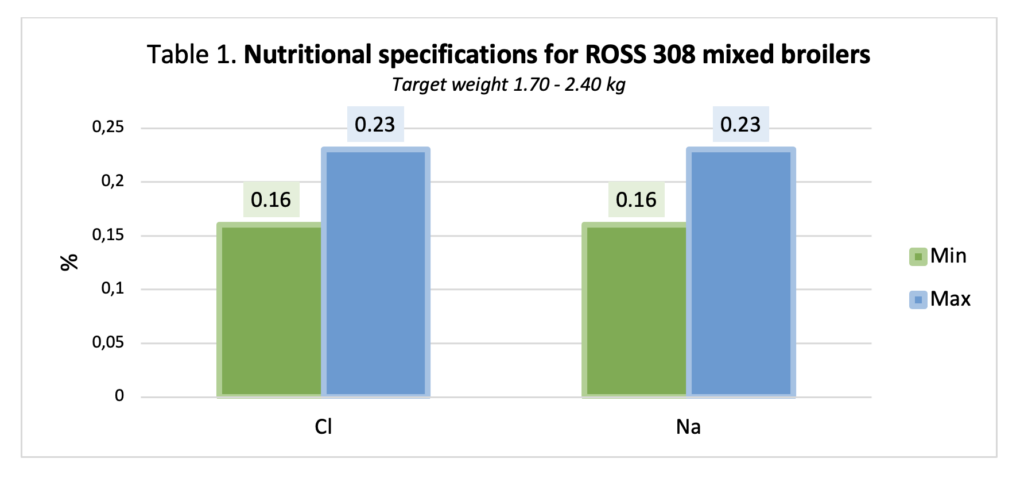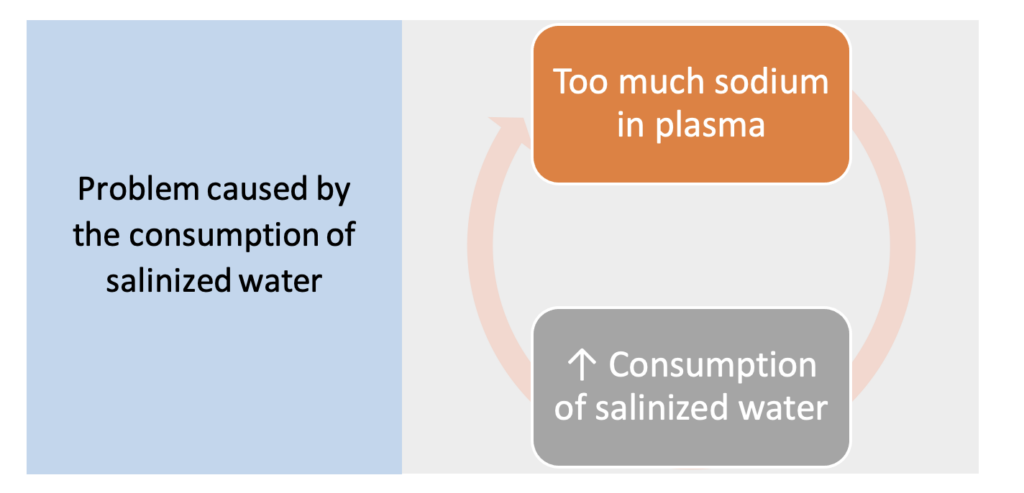Salt as a source of sodium and chlorine
Salt is an ingredient commonly used in poultry diets as a source of sodium (Na) and chlorine (Cl), important minerals for the organism. It is very rich in these minerals, as it has more than 95% purity, and specifically contains 38% sodium and 58% chlorine (Blas et al. 2019). Its addition in the diet is importance because the main ingredients, like cereals or soybean meal, are low in sodium; besides, chlorine in salt is highly bioavailable in poultry (Schaible 1941).
Requirements and maximum levels of sodium and chlorine in poultry
The diets must provide enough sodium and chlorine to meet the birds’ requirements in order to achieve optimal performance results, since deficiencies in these minerals negatively impact weight gain and feed utilization and can even cause pecking and cannibalism.
However, nutritional requirements in the commercial guides also mention maximum concentrations for these minerals in the feed (Aviagen 2019; Hy-Line 2016). This is because too high concentrations of these minerals have negative consequences on health and productive performance.

Salt poisoning
Too much salt, that is, sodium or chlorine, can cause poisoning in birds. Mainly, this excess can be due to two factors: the diet or the water.
Poisoning caused by feed
To prevent poisoning caused by feed, nutritional analyses of the diet must be conducted to make sure the levels of these minerals are adjusted to the bird’s requirements. The processes of addition of salt to the feed and feed mixing should also be evaluated to confirm that the composition is homogeneous.
Poisoning caused by water
Drinking water can also be an important source of sodium, for which it is important to consider its contribution as a mineral source when formulating the diet. If water is the causative factor for salt poisoning, it can lead to severe problems.
This is especially relevant in areas close to the sea, particularly during periods of drought: when the rains are scarce, the pressure of the groundwater decreases, and the seawater comes into the land through underground conduits. Seawater contains much higher salt concentrations, so when it reaches the wells used to supply water to poultry farms, the sodium amount that the animals receive can easily reach toxic levels.
Clinical signs
High salt intake make birds increase water consumption with the aim of reducing the concentration of this mineral in plasma (Bankir et al. 2017). When water is an important source of sodium, its consumption does not lead to a decrease of this mineral’s plasma levels, consequently, birds suffer from excessive water consumption and severe salt poisoning.
This excess of water is eliminated through the feces, leading to diarrhea. Liquid stools deteriorate litter quality, which is closely related to problems such as coccidiosis, respiratory problems related to high ammonia concentrations and foot-pad dermatitis, among others. Severe salt poisoning can even cause death.

Prevention of salt poisoning caused by salinized water
In areas where the phenomenon of water salinization takes place, water composition should be analyzed in the wells when the phreatic levels of water decrease to readjust the salt concentration in the feed.
In Delta Labs, we offer the feed formulation and analysis service to optimize feed composition and adjust it to the requirements of the target species, and to establish the possible causes of the problems that occur in the farm. We can also adjust the diets to the requirements of each area and season of the year so as to prevent salt poisoning.
To use these services, please contact us through our webpage www.globalvetslab.com or email at info@globalvetslab.com
References
- Aviagen. 2019. “POLLO DE ENGORDE ROSS 308: Especificaciones de Nutrición.” Aviagen Brand: 1–8. http://eu.aviagen.com/tech-center/download/782/Ross308-PS-NS-2016-ES.pdf (September 28, 2021).
- Bankir, Lise et al. 2017. “Relationship between Sodium Intake and Water Intake: The False and the True.” Annals of Nutrition and Metabolism 70(Suppl1): 51–61.
- Blas, C. de, P. Carcía-Rebollar, M. Gorrachategui, and G.G. Mateos. 2019. Tablas FEDNA de composición y valor nutritivo de alimentos para la fabricación de piensos compuestos FEDNA (Fundación Española Para El Desarrollo de La Nutrición Animal). 4th ed. Madrid. http://www.fundacionfedna.org/ingredientes-para-piensos.
- Hy-Line. 2016. “Management Guide. Aviary and Barn Systems. North America Edition.” : 21.
- Schaible, P.J. 1941. “The Minerals in Poultry Nutrition—A Review.” Poultry Science 20(3): 278–88.